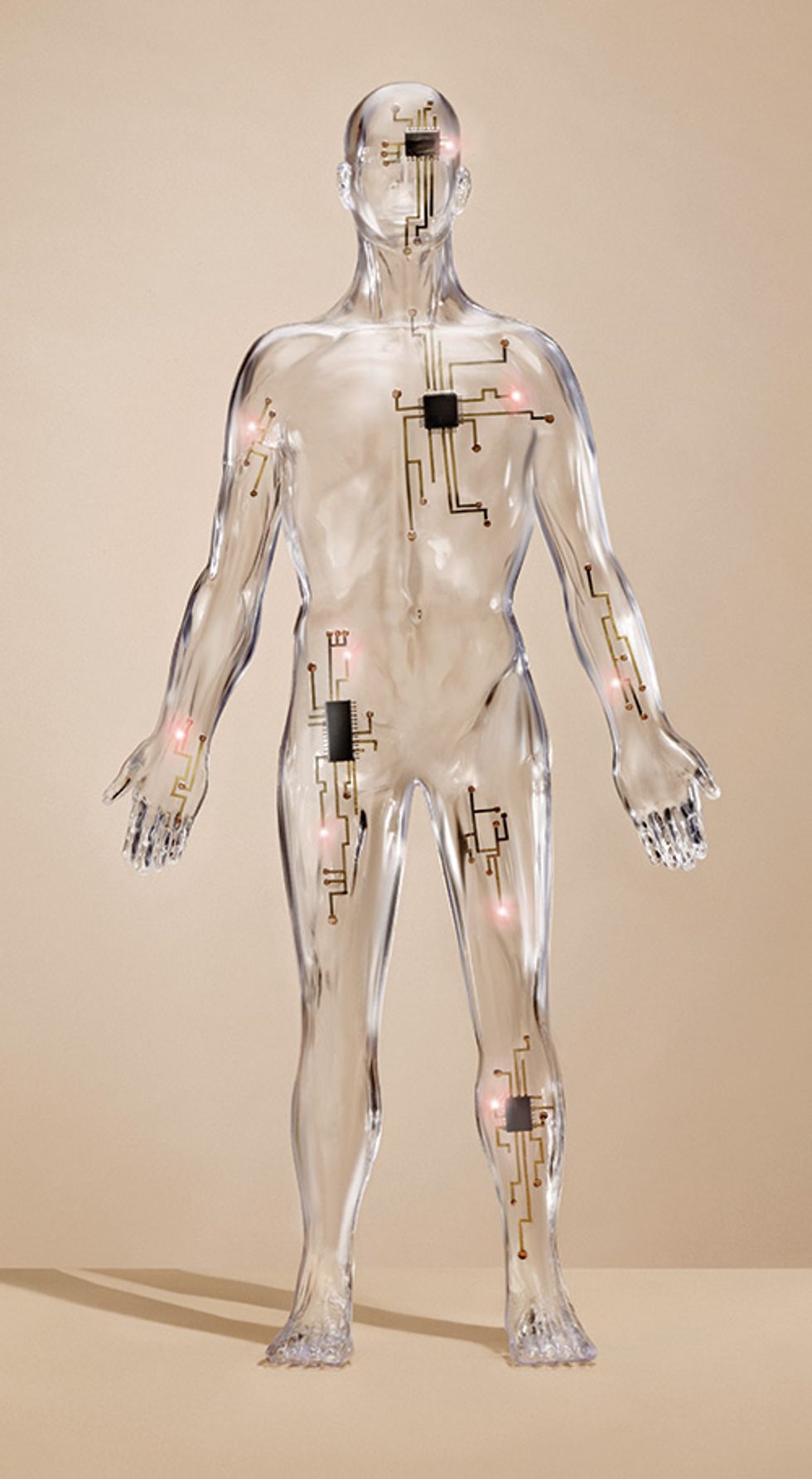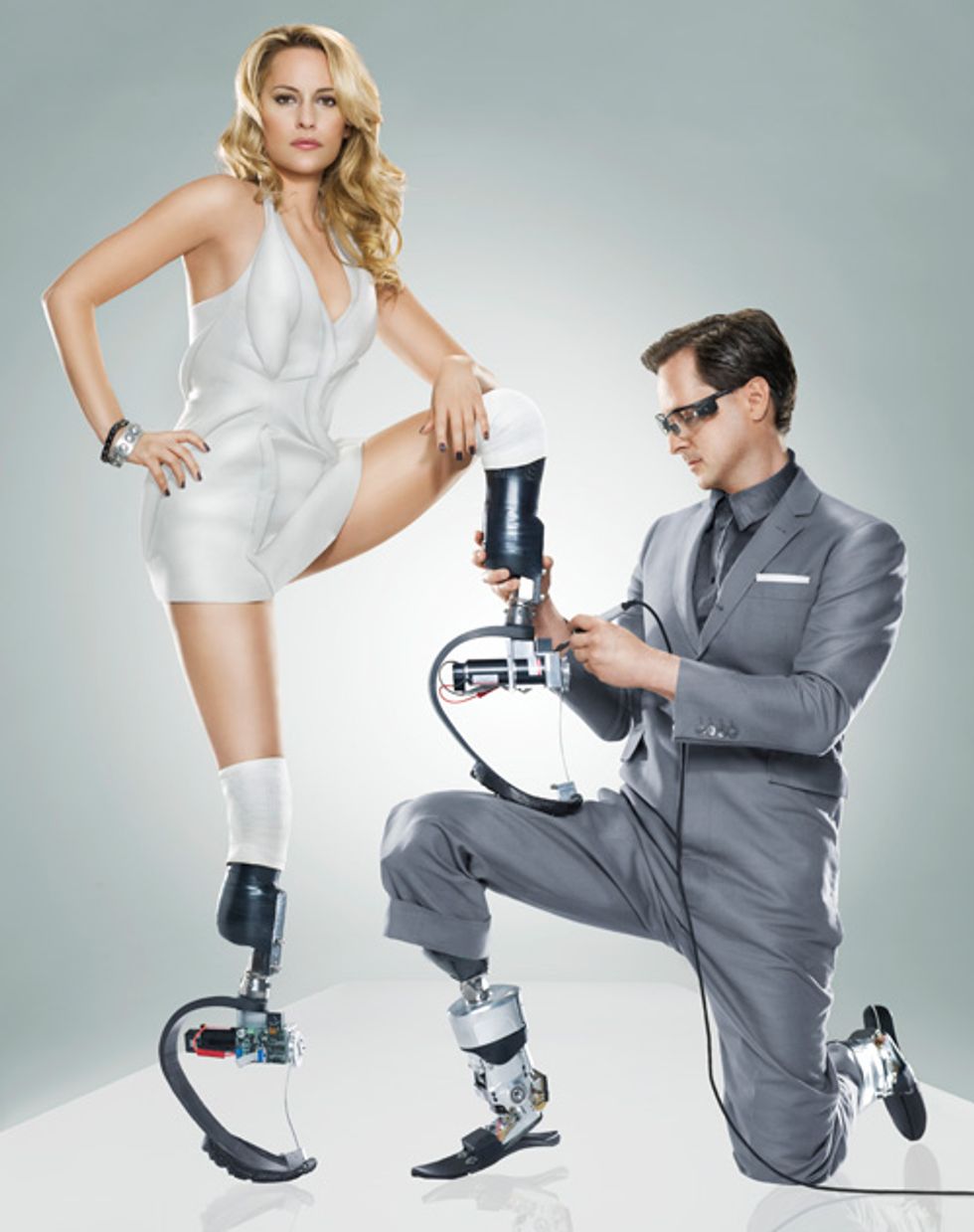We Will End Disability by Becoming Cyborgs
Neural interfaces and prosthetics will do away with biology’s failings


Hugh Herr is a living exemplar of the maxim thatthe best way to predict the future is to invent it. At the age of 17, Herr was already an accomplished mountaineer, but during an ice-climbing expedition he lost his way in a blizzard and was stranded on a mountainside for three days. By the time rescuers found him, both of his legs were doomed by frostbite and had to be amputated below the knee. Once his scars healed, Herr spent months in rehab rooms trying out prosthetic legs, but he found them unacceptable: How could he climb with such clunky things? Surely, he thought, medical technologists could build replacement parts that wouldn’t slow him down.
Today, three decades after his accident, Herr walks on bionic limbs of his own creation. As director of the biomechatronics group at the MIT Media Lab, Herr developed advanced prosthetics that he uses to walk, run, and even rock climb. And now, as he works with his colleagues to establish MIT’s new Center for Extreme Bionics, Herr is setting out not just to reinvent himself but the whole of society. “Fifty years out, I think we will have largely eliminated disability,” he declares, adding that he’s referring not just to physical disabilities but to many emotional and intellectual infirmities as well.
Herr believes the solutions lie not in biological or pharmacological cures but in novel electromechanical additions to our bodies. He gestures to his own artificial limbs to make the point. “My legs weren’t grown back; I wasn’t given a total limb transplant,” he notes. “If you eliminate the synthetics, all I can do is crawl. But with them,” he says with a slow smile, “I can more or less do anything.”The MIT scientists are part of a movement aimed at ushering medicine into a cyborg age. All over the world, engineers are building electronics-based systems that communicate directly with the human nervous system, promising radically new treatments for a variety of ailments and conditions, both physical and mental. While Herr’s team focuses on giving people better control of their prosthetic limbs, other researchers are trying to give patients better control of their emotions. One promising experiment targets depression with deep brain stimulation (DBS), in which electrodes implanted in the brain send steady pulses of electricity to certain problematic neural areas. Others are developing gear to compensate for intellectual deficits, such as a California project to build a memory-augmenting prosthetic.In all of these projects, researchers started with the notion that a surprising range of afflictions can be most effectively treated by learning the electrical language that the brain uses to govern our movements, moods, and memories. By 2064, it’s entirely possible that neural engineers may be fluent enough to mimic those instructions, allowing them to repair a human being’s faulty systems by rewiring them.
The body is electric. We’ve known that since the 18th century, when Luigi Galvani touched a charged scalpel to a nerve and made a dead frog’s leg kick. Neurons in the brain send out pulses of voltage when they “fire,” and the patterns of their pulses make up our sensations, our musings, and our actions. The electric signals generated in the brain also travel through the spinal cord and along the peripheral nerves to instruct the body’s muscles and organs. Medicine in the 20th century relied primarily on pharmaceuticals that could chemically alter the action of neurons or other cells in the body, but 21st-century health care may be defined more by electroceuticals: novel treatments that will use pulses of electricity to regulate the activity of neurons, or devices that interface directly with our nerves.
Herr’s lab focuses on advanced prosthetic legs, and it is developing systems that will allow amputees to control a titanium-and-plastic limb as naturally as they would a flesh-and-blood leg. The goal is to record and understand the brain’s commands and then to send those instructions to the prosthetic. Herr has already tested an early version of such an integrated device. In that setup, he flexed the muscles around his knee as if he were taking a step; then an electromyograph captured the electric signal in those muscles and translated it into a digital signal that made sense to the microprocessors in his artificial foot. Just like that, he stepped.
Even more direct connection between brain and machine will be possible, Herr says, when he succeeds in connecting prosthetics directly to the peripheral nerves in amputees’ residual limbs. Not only could such a system relay more precise commands to the prosthetic, it could also send sensory information back up the nerves. And when amputees actually feel the grass beneath their prosthetic toes, Herr says, it will change the way humans view this technology. “When that happens it will not matter what [the prosthetic] is made of, it will be you,” he says. “I feel, therefore I am.”
People with bodily disabilities typically have a moment that marked the onset of their troubles—for example, Hugh Herr’s ill-fated climbing excursion. In contrast, people with the crushing emotional difficulty of depression often don’t know when it started, nor do they necessarily define themselves as disabled. Depression is just the state of mind they live with daily, stripping the present of all pleasure and the future of all hope.
Neuroscientists discovered years ago that this existential dread can be treated by using electricity to alter the activity of neurons, and they are now putting that knowledge to use. DBS, one of the most exciting experimental treatments for depression, uses an implanted “brain pacemaker” that sends steady pulses of electricity to certain brain regions. It’s a technology that was pioneered to stop Parkinson’s patients’ tremors, but it’s now being explored for a dizzying array of neural and psychiatric disorders, including depression, obsessive-compulsive disorder, and PTSD. “Right now we’re at the beta testing stage of DBS for psychiatry,” says Helen Mayberg, a neurology professor at Emory University and an authority on DBS for depression.
More than 100 000 Parkinson’s patients have had electrodes implanted in the motor control regions of their brains, where the stimulator’s pulses reduce the activity of neurons that are misfiring. But for disorders like depression, both the target for treatment and the mechanism of action are considerably less clear. “The limiting factor is actually the neuroscience, not the engineering,” Mayberg says. She used brain imaging studies to pinpoint a particular region, Brodmann area 25, as overactive in depressed patients, and she has implanted the DBS device in this region of the brains of about two dozen patients who haven’t responded to a slew of medications and therapies.
These test subjects are desperate, so overwhelmed by depression that they’re willing to undergo experimental brain surgery. And the results have been remarkable. While antidepressant medications typically take weeks to kick in, many patients in the DBS experiments have reported a shift in mood instantly—literally the moment that the device is turned on. One patient reported an immediate sense of social connection; another expressed a desire to go bowling, a pastime she hadn’t enjoyed for years. Most patients have chosen to keep their DBS systems activated after the formal experiments ended, and Mayberg says she’s seen ample evidence that their improved lives can’t be chalked up to a placebo effect. “When my patients’ batteries die, they know it,” she says.
Bespoke Medicine
While engineering will play a central role in 21st-century medicine, biological treatments will hardly vanish. Those treatments will be shaped by the coming ubiquity of cheap genome sequencing, which will enable a new model of personalized genetic medicine. The change will start in the maternity ward, where newborns in their bassinets will receive full genome scans, resulting in complete printouts of their genetic vulnerabilities. Then, as those babies grow up and proceed through life, their physicians can design custom-made health-care regimens to ward off trouble and can prescribe the medications that their bodies will respond to best. Today the cost of a genome scan is nearing US $1000, and the scans are becoming common in cancer hospitals. When the price drops to $100, they’ll be common everywhere. —E.S.
Despite the dramatic results in DBS depression treatment, there was a setback in the field last year when a major clinical trial was halted. The device manufacturer, St. Jude Medical, announced that the trial it had funded failed a “futility analysis,” but it hasn’t explained exactly what went wrong. Mayberg notes that there are many variables that can influence the effectiveness of DBS; for example, even if the trial had targeted the correct region, the timing of the pulses may have been off. St. Jude may have rushed ahead too quickly, she says, trying to create a commercial product before the basic science of how such devices work is truly understood.
The good news for all would-be brain engineers is that massive neuroscience initiatives have recently been launched in the United States and Europe. The BRAIN Initiative, announced by U.S. president Barack Obama in 2013, will dedicate hundreds of millions of dollars to developing new tools that can better record and analyze brain activity. In Europe, meanwhile, the Human Brain Project is using supercomputers to simulate a complete human brain so as to better understand how it functions. It’s very possible that in 50 years, DBS and other electrical techniques will be part of mainstream psychiatry, Mayberg says. But that will require scientists to know as much about the workings of a neuron as engineers do about the workings of an electrode.
Once physical and emotional disabilities have been conquered, the intellectual failures associated with aging will be a natural next target, says Theodore Berger, a professor of biomedical engineering at the University of Southern California. In fact, by 2064, going cyborg may simply be the sensible and economical thing to do. “We’re living longer, so aging problems, and cognitive problems in particular, are going to be more and more prevalent,” Berger says. “The cost of a cognitive prosthetic will pale in comparison to taking care of a person with dementia for 20 years.”
It’s quite possible that Alzheimer’s patients of the future will be equipped with memory prosthetics derived from the devices being invented in Berger’s lab today. His work began with delicate electrodes inserted into a rat’s hippocampus, the brain structure responsible for encoding memory. Berger first deciphered the relationship between the input signals from neurons that process a brief learning experience—for example, which lever a rat should press to gain a sip of sugar water—and the output signals from neurons that send the information on to be stored as a memory.
Once he had mapped the correlations between the two electrical patterns, Berger could record an input signal and predict the output signal—in other words, the memory. He didn’t need to know which part of the input pattern coded for the dimensions of the lever or for the taste of the sweet reward. He simply mathematically generated the output signal and sent it to the memory-storage neurons. “It’s like translating Russian to Chinese when you don’t know either language,” Berger says. “We don’t want to know either language; we just want to know how this pattern becomes that pattern.”
Berger proved that he could implant the memory of the lever-and-reward test in a rat with a damaged hippocampus that was unable to form memories on its own. Even more remarkable, he implanted the memory in a rat that had never before undergone the test or seen the levers. The rat entered the test chamber for the first time, pressed the correct lever, and sucked down the sweet nectar.
With the knowledge of how to record and store memories, Berger can imagine a prosthetic device that encodes memories on a chip. He and his colleagues have already advanced to primate experiments, and he expects to proceed to the first human trials in the coming years. “It will absolutely happen,” he says. In 50 years, he says, elderly people could have devices that they switch on to remember something as trivial as where they put their car keys or as meaningful as their grandchildren’s names.
Berger optimistically believes his technology will be embraced, but it’s easy to imagine a backlash against such synthetic additions to our fleshy bodies. Back at MIT, Hugh Herr says he’s heard from plenty of people who are frightened by his predictions of physical, emotional, and intellectual augmentations. He echoes their typical refrain: “Will we change humans so much that they cease to be human?” But Herr believes that such philosophical questions will fall by the wayside as broad swaths of patients begin to benefit from their machined parts. He imagines a world in which amputees gain freedom, depressed people find joy, and the elderly hold on to their life stories. “People are suffering horribly now,” Herr says, “and that’s going to end.”
What Could Possibly Go Wrong?
Cyborg Castes
Biomedical enhancements could lock in inequality
Illustration: MCKIBILLO
No one who works on the biomedical frontier believes that humans will be content with using advanced prosthetics and brain implants only for repair. Once these technologies have been proven safe and reliable for people with disabilities, some people with unimpaired bodies will start clamoring to use them as technological augmentations.
MIT’s Hugh Herr imagines that synthetic body parts could easily become more desirable than biological parts, especially as people age. “You wake up at the age of 50 and your joints are stiff, but your friend has bionic limbs that he upgrades every year that make him feel like an 18-year-old,” Herr says. “What would you do?”
Meanwhile, Theodore Berger at the University of Southern California has already tried his memory prosthetics on rats that have no cognitive deficits. He found that he could dramatically boost the rats’ performance on memory tasks. When the prosthetics were activated, “it was remarkable how much better they did,” he says.
Such physical and cognitive enhancements could benefit individual humans but take a terrible toll on humanity as a whole, argues Nicholas Agar. An associate professor of philosophy at Victoria University of Wellington, in New Zealand, Agar is the author of several books that are critical of radical human enhancement. “When you introduce these technologies into a society where there are vast inequalities of wealth, what’s the effect of that?” he asks.
Augmenting technologies might seem like a novel form of cosmetic surgery at first, just another way for wealthy people to boost their egos or improve their quality of life. But cognitive enhancements in particular could quickly create an elite class of cyborgs who go to the best schools, get the best jobs, and run the world. Agar worries that the divisions between the haves and have-nots would eventually be locked in by reproductive isolation. “What are the dating prospects between someone who has access to cognitive enhancements and someone who hasn’t?” he asks. —E.S.
This article originally appeared in print as “The End of Disability.”

